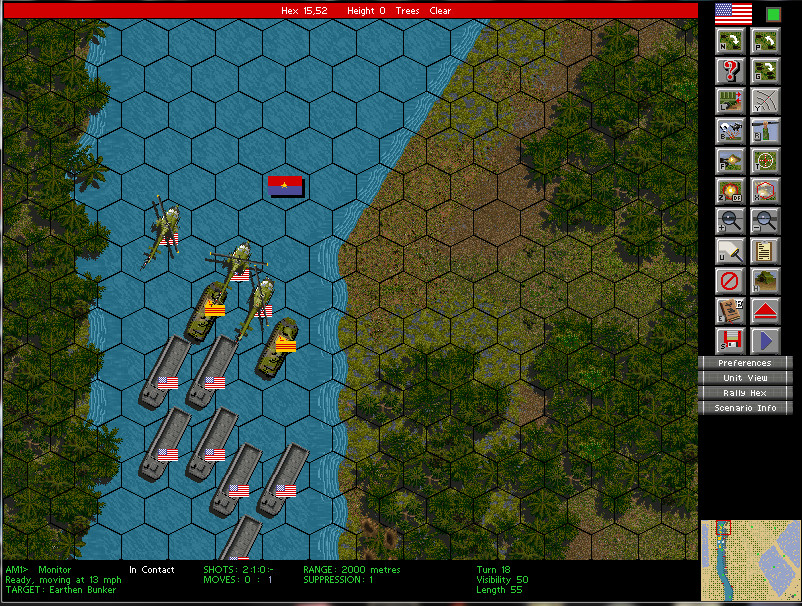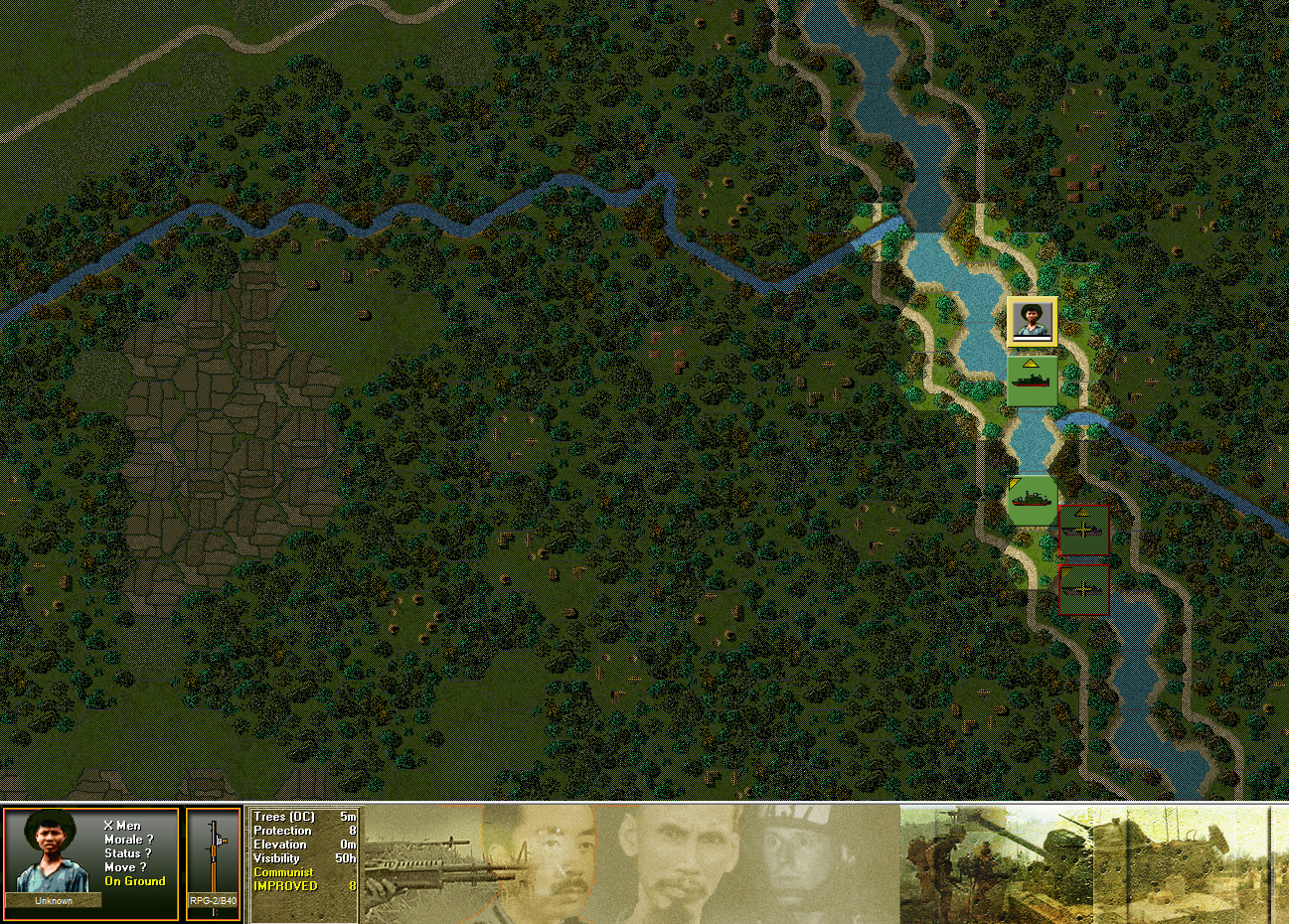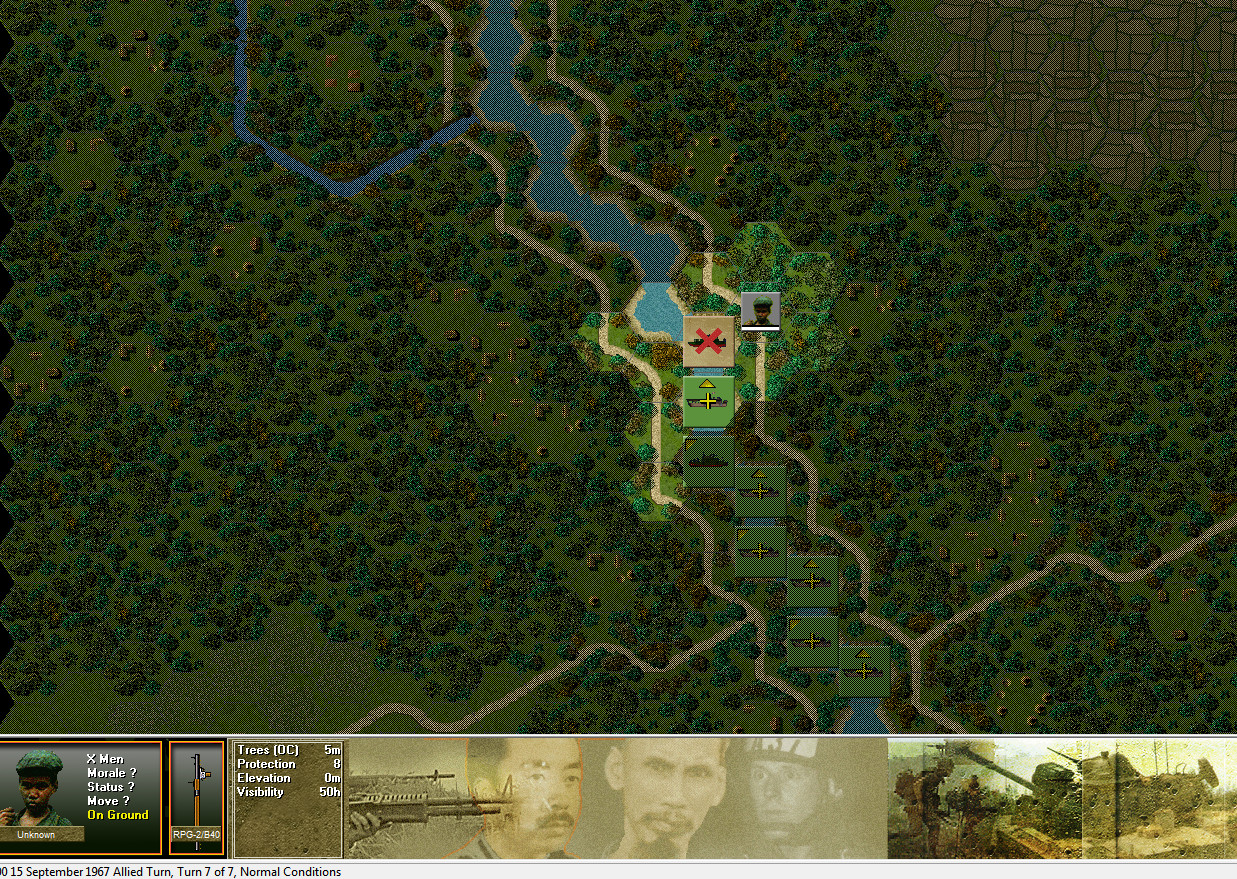Tags
Cold War, robert burns, Seven Firefights in Vietnam, Squad Battles, Squad Battles: Tour of Duty, Steel Panthers, Vietnam, WinSPMBT
This is the seventy-seventh in a series of posts on the Vietnam War. See here for the previous post in the series or go back to the master post.
It has been the better part of a year since I’ve delved into one of the Seven Firefights in Vietnam. So as to bring an end to my hiatus, I once again open the book (figuratively speaking, that is; I use the downloaded PDF) to the chapter titled Fight Along the Rach Ba Rai.
The Rach Ba Rai is a tributary to the Mekong River. It became the focus of an operation when two fleeing Viet Cong battalions took sanctuary in the Cam Son Secret Zone about 10 km upriver along the Rach Ba Rai. The riverine forces of the 9th Infantry were to provide the keystone of an operation to trap and annihilate the enemy force. Amphibious landings would allow the placement of battalion-sized infantry forces positioned to pen in the Viet Cong.
We all know what can happen to the best laid plans. This one, as Robbie Burns warned us it might, gang aft-a-gley.
As the U.S. force moved up-river, they sailed into a prepared ambush. The combination of surprise, confusion, and adherence to plan and doctrine meant that the assaulting force, initially, had to abandon the amphibious landing, withdrawing to regroup and to try again. The hours of delay meant that darkness overtook the operation before it could be fully executed and the next morning saw that the enemy had withdrawn and escaped. The third element – the application of plans and doctrines and the constraints that those apply to operations are generally absent from wargaming – and so it is here. Nobody can make me go through multiple attempts at the landing and I’d surely lose the scenario if I played it that way. As far as surprise and confusion go, however, I figured the best way to subject myself to that was to play the scenario in Steel Panthers before I read any of the details about the battle.
The last time I broke out Steel Panthers, I complained about the loss of sound in my installation but that has not been the end of it. In the intervening months, I’ve also lost my graphics. At least partially. I’ve explained before that the free version of the game is hobbled by restrictions on the graphical resolution. The choice is to play on a tiny window or to play in full-screen mode, converting your state-of-the-art monitor into a circa-1991 low-res eye irritant. Unless I’m taking screenshots, I prefer the latter. I’d rather look at ugly than struggle to read the texts.
Suddenly, however, my full-screen mode produces a black and white rendering of the screen. By this I mean, quite literally, black and white. Not even gray scale. Some elements of the screen can still be picked out, but most of what is rendered is completely unreadable. Playing in a window, however, works as it always has.
As before, there are probably explanations for this. Over the last year or so I’ve had (separately and many months apart) failures of both my graphics card and my monitor. Timing wise, I can probably narrow it down to the latter. Details of what happened probably need to be saved for a future post but, suffice to say, I did a lot of fiddling with my graphics settings before, ultimately, putting the exact same model monitor back in place. Could I have, somewhere in all that adventure, adjusted that one setting that WinSPMBT depended on to take over my screen? That seems almost a certainty. Yet, to date I’ve not found another* game similarly affected.
So launching the scenario Fight Along the Rach Ba Rai in the tiny window, I proceeded to play. There is nothing terribly new about the experience. I’m pretty sure I’ve never seen the “monitors**” included before, but amphibious operations are old hat. What fits the engine fairly well is the size and scope of the battle. Three battalions of attackers attempt to isolate and destroy a suspected 2 battalions of Viet Cong. Although a single scenario, it takes place in two phases. The landing force must be delivered through the ambush to the landing site, after which a number of land-based objectives must be taken.

This scope also highlights the shortcoming in this scenario. As is often the case, a full day’s worth of fighting is compressed – this time into several hours of play. Thus there is no time for the various shifts in objectives. As the U.S. player, you have roughly just the right amount of time to do everything you need to do… no more, no less.
It is not explicitly stated but my take is that the scenario starts with the second run up the river, after the aborted first attempt. This explains, although not perfectly, some of the starting conditions. It also exacerbates the unrealistically high casualty rate. From Seven Firefights in Vietnam I gather that many of the combat casualties occurred during the ambush phase – during the confusion that occurred during that first run up the river. I tried to enhance that confusion via the play/read order. Squad Battles, by contrast, explicitly portrays the ambush as its own scenario.

In Squad Battles: Tour of Duty, the treatment of this battle is presented*** as a scenario pair. Like some other multi-part Squad Battles scenarios (at least, as I see it), the first of the two is meant to be illustrative of the operation’s problems – a sort of an introduction to the second part. The scenario is only 6 turns long and consists entirely of running the gauntlet of the Viet Cong ambush. Granted, it is possible to fight the scenario in a non-historical way. For example, a player could opt to disembark the assault force early**** to deal with the ambush. I think the real point is to illustrate why the U.S. had to make two tries at running the VC gauntlet.

Naturally, given the vagaries of the Squad Battles system, I did even worse than my historical counterparts. Whether that’s due to overpowered anti-armor weaponry, over-modelling the proficiency of the enemy, or some combination of the two, I’ll not speculate. While the historical American forces did take a lot of damage and suffered serious injury, they didn’t see the loss of their gunboats (as shown in the below screenshot) and suffered only 7 KIAs. Worse yet, the modeling of the river as a narrow channel means that two sunk monitors (each taken out by a single RPG, I might add) are sufficient to block the entire river and prevent passage of the remaining fleet.
That definitely didn’t happen. Nor, I don’t believe, could it have.

The second part of the scenario begins with the gauntlet successfully overcome. Although I didn’t know it (nor would you have, had you not read this far), the landing itself is completely uncontested and the point of the exercise is moving inland and taking enough ground to call it a victory.

The tighter focus and shorter scenario length, when contrasted with Steel Panthers, help with the resulting realism. At the same time, the narrow river and hex-side landing sites provide a very different feeling relative to the other game’s version. The written record does not give me enough information to definitively decide which is right and which is wrong but Squad Battles doesn’t quite feel right. There’s also the fact that Squad Battles doesn’t seem to have the mechanics to allow for a satisfying, decisive finish.
A balanced scenario is going to be one of maneuver and attrition. Without reasonable modeling of the off-board fire support, the U.S. play cannot really “sweep the field.” As it was, I took some of the victory locations and left others in the hands of the enemy. For both versions of this battle, it was enough for me to win on points. In both cases, like my historical counterparts, I found my victory lacking in meaning and import.
Return to the master post or continue on to the next post. My struggle to master the A-1 Skyraider continues as I work my way through some 1965 historical missions. I also posted an update about my timeline where I try to get control of its excesses. You might, alternatively, want to leap ahead to where I post further discussion about this battle.
*Off the top of my head, my oldest games are set up to run in DOSBox, which does not appear to be affected. I’m quite sure I’ve got some other non-native-resolution, full screen games. I can’t think of what they’d be right off the top of my head.
**Quite obviously a reference to the Civil War gunboat, the Vietnam version bears a passing resemblance to its namesake. It appears to be something of an improvised (as far as the Military-Industrial Complex can be said to improvise) solution to the requirements of fighting on rivers. It uses the basic platform of the littoral landing craft, but mounts heavy weaponry to provide support for the riverine missions.
***As his source, Tiller cites Seven Firefights in Vietnam, which is also my source for additional background. It is therefore confusing to me the mistake baked into the SB: Tour of Duty scenario pair. In the description, the game puts the two scenarios a day apart. Per the source, the second attempt was launched “just after 1000,” which would make it nearly six hours after the operation began (0415). Although air assaults on presumed enemy positions continued through the night into the pre-dawn hours of the September 16th, no contact took place and the enemy positions were found to be abandoned “the next morning.”
****In reality, the infantry forces did fight against the ambushing positions but only from the decks of their transports. As it was, the grenade launchers, in particular, proved to have some effect against the prepared positions of the enemy. In Squad Battles, however, mounted units cannot engage with their weaponry.

Pingback: Giggity | et tu, Bluto?
Pingback: Go, go, go like a Soldier | et tu, Bluto?
Pingback: Between the Heavens and the Corner of some Foreign Field | et tu, Bluto?
Pingback: I’m Queen of the Castle | et tu, Bluto?
Pingback: With Positive Reply | et tu, Bluto?
Pingback: Tipping my Hand | et tu, Bluto?
Pingback: Rach and Roll | et tu, Bluto?
Pingback: The roar of guns and cannons almost made me cry | et tu, Bluto?